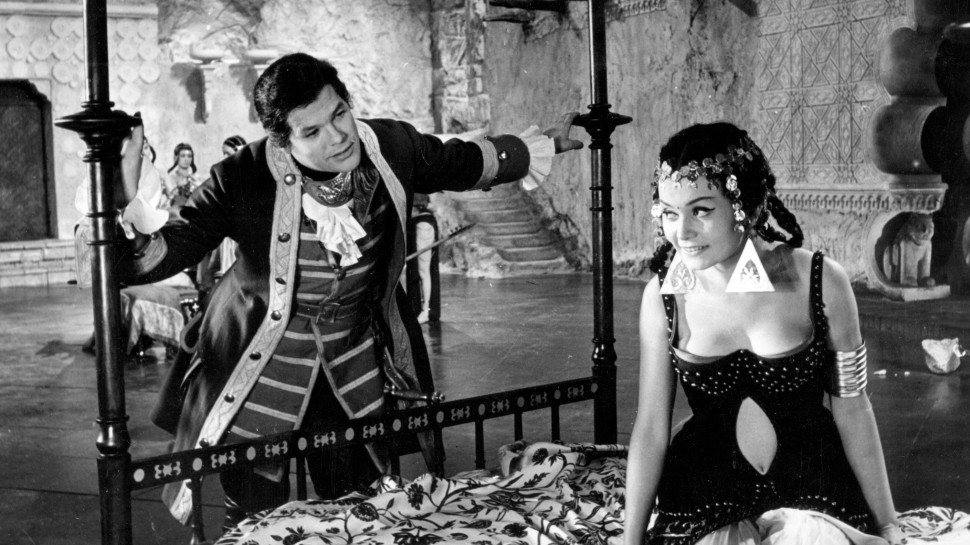There are as many variations upon narrative form as there are filmmakers. Few have been able to construct films that sustain a narrative whose story arcs and plot points are dictated by dream logic and function to assess the validity of narrative formats. The best known examples of this particular brand of filmmaking can probably be found in the works of Cocteau, Zulawski and Tarkovsky. But the greatest cult film of this particular kind of is arguably Wojciech Has’ epic The Saragossa Manuscript (1965).
The Saragossa Manuscript tells of the Homer-esque journey of van Worden (Zbigniew Cybulski). Along his journey, various encounters in surrealist locales unfold and prompt stories of their own. Has arranges the tale of van Worden so that the character, through his encounters with various persons, accompanies the audience through various legends in a narrative format not dissimilar to an Italian omnibus film such as Love & Anger (1969). These legends, told by the people whom van Worden encounters, appear as vignettes framed by the connecting storyline of van Worden himself. In the tradition of story telling, which is at the center of the film, each vignette tells a moral tale. Has is therefore directing his audience to analyze The Saragossa Manuscript as an analysis of Polish folklore along with its social ramifications (this film, along with those of Eric Rohmer, was a major influence on the live-action films of Walerian Borowczyk).

Until the advent of narrative filmmaking in the early twentieth century, stories that were told and retold generation to generation dominated the psyche of the Eastern European working classes. What Has does, and he is correct in doing so, is assume that this method popular storytelling has been replaced or, better yet, mutated by the cinema. This point brings me to what I consider the most effective continuation of this methodology, David Lynch’s Inland Empire (2006).
Unlike Has, Lynch is not confined to the more linear elements that run throughout The Saragossa Manuscript, but is only confined by how film can reflect a narrative insofar as that narrative is a dream. In Lynch’s film Laura Dern plays three parts, an actress, a housewife and a hooker. Their individual stories are linked in that Laura Dern represents the viewer in the context of the film. Inland Empire becomes a dream in which Lynch is literally incorporating his audience. Has’ audience, on the other hand, related to van Worden, who guided them through his dreams and by doing so, shared them. Lynch does away with such an approximation, allowing film itself to fill that gap.
The main reason Lynch can allow his audience to pilot their own experience of the Inland Empire dream is that, unlike Has, Lynch is not interested in the art of story telling (at least in the same sense Has is). Lynch is making his film forty years after Has, and by now Lynch’s aesthetic depends more on implications than explanations or impressions as opposed to expressions. In this way Inland Empire becomes wholly reflexive.
There is no clear understanding to be gained from viewing Inland Empire in a narrative sense. Its primary goal is to simply work the magic of a dramatic narrative implementing only the visual and auditory tricks of film as a medium. In a sense, Inland Empire is raw cinema, meant to be experienced not understood. Lynch is pushing the work Has began into the realm of “total cinema”. Both films are vignette films and both have clear moral implications, yet Inland Empire is devoid of a linear plot while The Saragossa Manuscript is entirely dependent upon that premise.
This anomaly should come as no surprise to those familiar with Lynch’s work in the cinema. His first feature Eraserhead (1977) flirted with the concepts Lynch allows to flourish in Inland Empire. Not surprisingly either, Lynch is a great admirer of classic Polish and Czech films. He even shot portions of Inland Empire in Has’ native Poland.
What is most significant about what these films represent is a progression of the cinema into the popular psyche of audiences. In 1965 a commercial director could never have attempted what Inland Empire does. Still, Lynch has done it and he’s done it well. But it would have been impossible without the intervening forty years and films like The Saragossa Manuscript.
